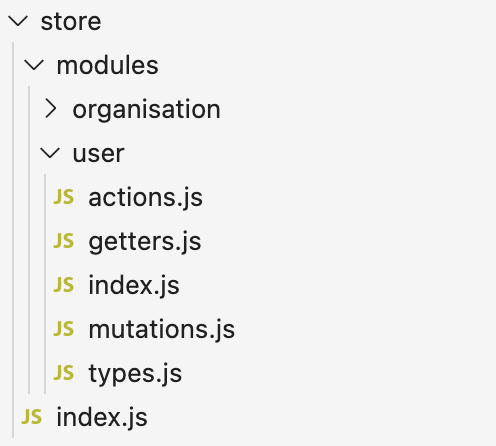An Interest In:
Web News this Week
- April 26, 2024
- April 25, 2024
- April 24, 2024
- April 23, 2024
- April 22, 2024
- April 21, 2024
- April 20, 2024
How To Structure a Massive Vuex Store for a Production App
When looking at Vuex tutorials, you can see most of them are quite simple.
The logic is explained well, but scalability suffers. How will this work in my production app?
Heres a simple store example from Vuex official docs:
import Vue from 'vue'import Vuex from 'vuex'Vue.use(Vuex)const store = new Vuex.Store({ state: { count: 0 }, mutations: { increment (state) { state.count++ } }})Theres no need to explain this. I assume that you already have some Vue and Vuex knowledge prior to this article.
My goal is not to explain what a store, state, or mutations are.
Instead, I want to show you a massive store with 1,000+ state attributes, mutations, actions, and getters.
I want to teach you how to structure the store for the best maintainability, readability, and reusability.
It can have 100,000+ attributes. It would still be clear.
Lets dive in.
Meet Modules
As we already said, keeping everything in one file will create a mess. You dont want a 50,000+ LOC file. Its the same as keeping your app in one component.
Vuex helps us here by dividing the store into modules.
For the purpose of this example, I will create a store with two modules. Note that the process is the same for 100+ modules, as well as 100+ actions, getters, and mutations within every module.
const userModule = { namespaced: true, state: () => ({}), mutations: {}, actions: {}, getters: {}}const organisationModule = { namespaced: true, state: () => ({}), mutations: {}, actions: {},}const store = new VueX.Store({ modules: { user: userModule, organisation: organisationModule }})store.state.user // -> `userModule`'s statestore.state.organisation // -> `organisationModule`'s stateThe namespaced attribute is incredibly important here. Without it, actions, mutations, and getters would still be registered at the global namespace.
With the namespaced attribute set to true, we divide actions, mutations, and getters into the modules as well.
This is really helpful if you have two actions with the same name. Having them in a global namespace would create clashes.
const userModule = { namespaced: true, state: () => ({}), mutations: {}, actions: { 'SET_USER'() {}, 'SET_USER_LOCATION'() {} }, getters: {}}store.state.user['SET_USER']() // correct stote.state['SET_USER']() // wrong As you can see, the module is completely local right now. We can access it only through the user object on the state.
Exactly what we want for our massive application.
Cool, now we have a store divided into modules!
However, I dont like the hardcoded strings for actions. Its definitely not maintainable. Lets address this issue.
Types To Save You From Headaches
We dont just want to access every property from every module in every file. That sentence sounds like hell.
We want to import them first. Then use mapGetters, mapActions, or mapMutations to achieve that.
// userModule.jsexport const SET_USER = 'SET_USER'export const SET_USER_LOCATION = 'SET_USER_LOCATION'const userModule = { namespaced: true, state: () => ({}), mutations: {}, actions: { [SET_USER]() {}, [SET_USER_LOCATION]() {} }, getters: {}}// vue fileimport { mapActions } from 'vuex'import { SET_USER, SET_USER_LOCATION } from './userModule.js'...mapActions({ setUser: SET_USER, setUserLocation: SET_USER_LOCATION})This gives you a clear view of store attributes used by your Vue file.
But thats not enough. Everything is still in one file. Lets see what we can do to scale it properly.
Folder Structure
Ideally, we want to split modules into different folders. Within those modules, we want to split their mutations, actions, getters, state attributes, and types across different files.
The desired folder structureFolder store will be created in the root folder of our project.
It will contain two things:
index.jsfilemodulesfolder
Before explaining the index.js file, lets see how we divide a single module. Lets check the user module.
All of its actions, mutations, and getters should be listed in the types.js file. So, something like:
// actionsexport const SET_USER = 'SET_USER'export const SET_USER_LOCATION = 'SET_USER_LOCATION'// mutations// gettersWell have a clear view by importing those consts every time we want to use them.
Lets look at the actions now. We want to move them to the actions.js file.
To do so, we only need to copy the actions object within the module and export default it, while importing the types:
import { SET_USER, SET_USER_LOCATION } from './types.js'export default { [SET_USER]() {}, [SET_USER_LOCATION]() {}}We will do the same thing for mutations and getters. The state attributes will remain in index.js (within the user module folder):
import actions from './actions.js'import mutations from './mutations.js'import getters from './getters.js'const state = {}export default { namespaced: true, state, actions, mutations, getters}Now we have all of our modules divided into multiple files.
The one thing remaining is to link all those modules in the index.js file within the store folder:
import Vue from 'vue'import Vuex from 'vuex'// Modules importimport UserModule from 'modules/user'import OrganisationModule from 'modules/organisation'Vue.use(Vuex)const state = {}const actions = ({})const mutations = ({})const getters = ({})const modules = { user: userModule, organisation: organisationModule}export default new Vuex.Store({ state, actions, mutations, getters, modules})Conclusion
By using this architecture, we had zero problems with scalability in our massive production app.
Everything is so easy to find.
We know exactly where all the actions are triggered.
The system is highly maintainable.
If you have any recommendations for the improvements, please let me know. I would love to hear your opinion.
Original Link: https://dev.to/domagojvidovic/how-to-structure-a-massive-vuex-store-for-a-production-app-97a
Dev To
 An online community for sharing and discovering great ideas, having debates, and making friends
An online community for sharing and discovering great ideas, having debates, and making friendsMore About this Source Visit Dev To


